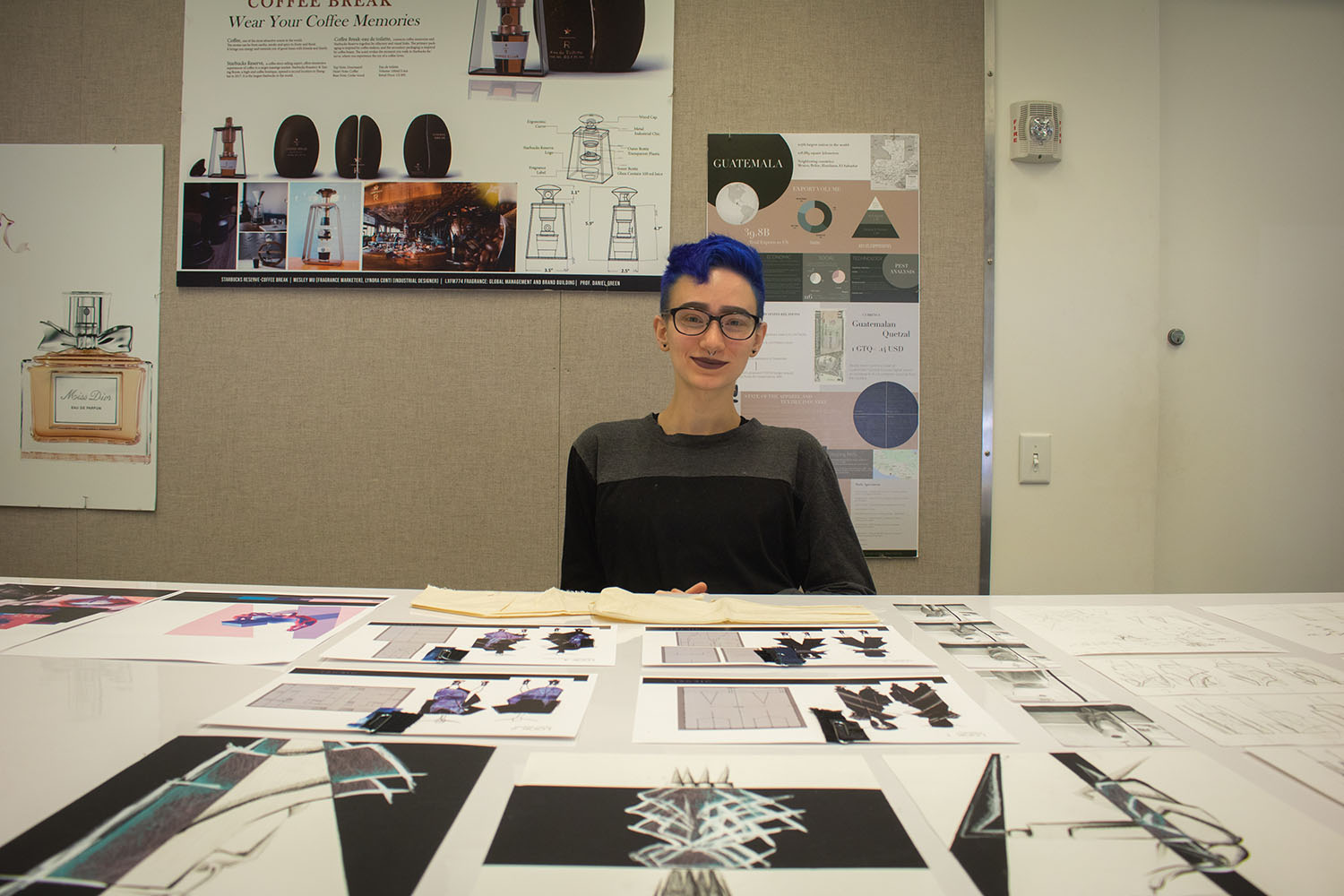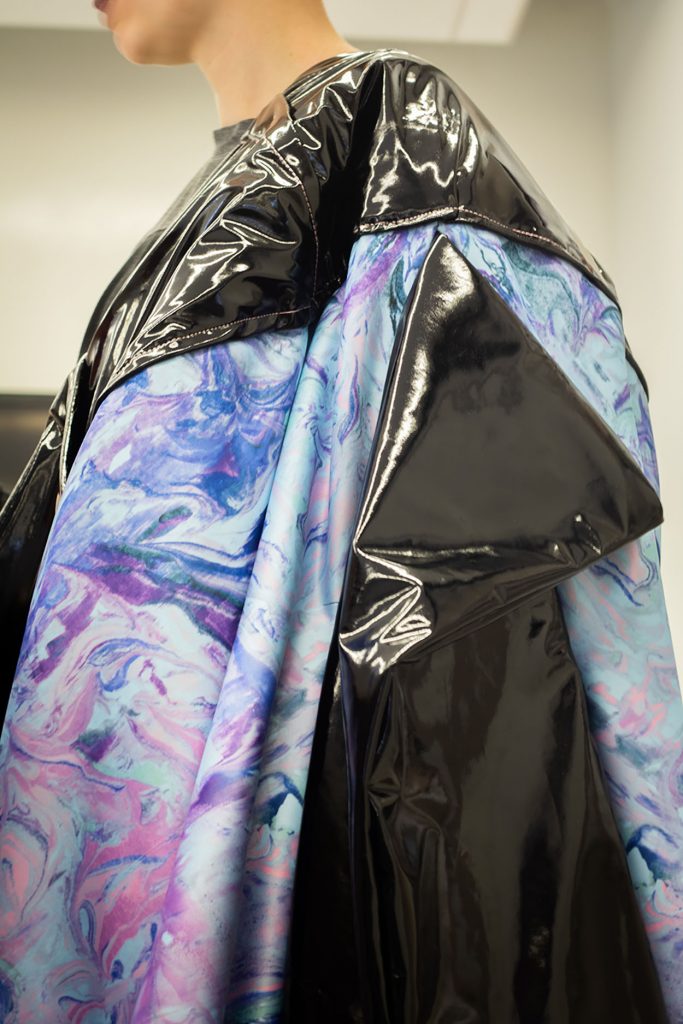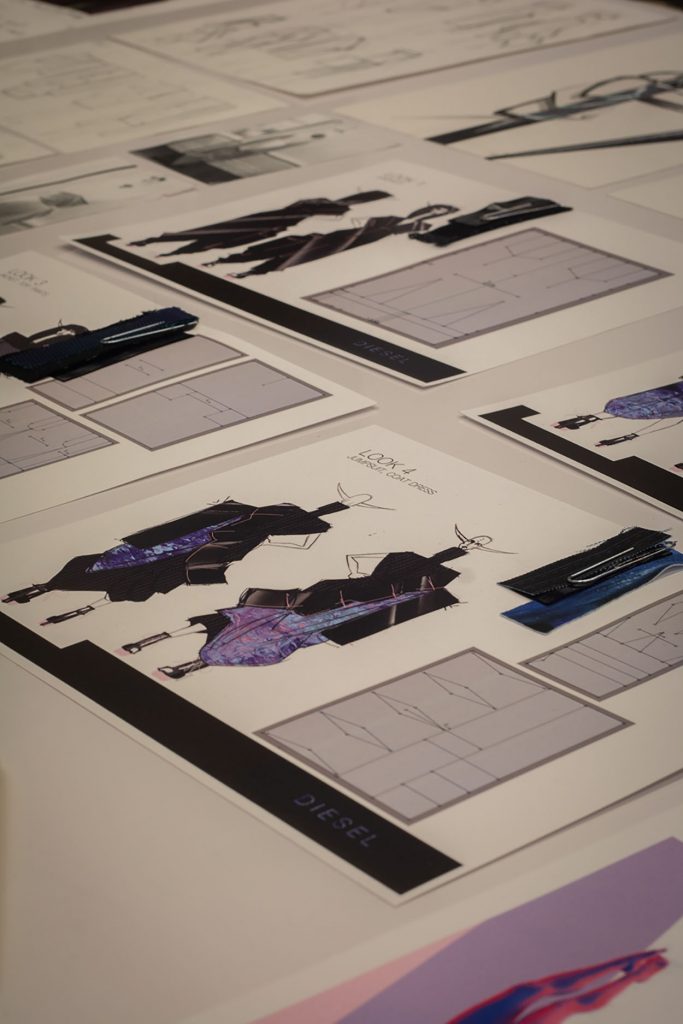As we approach the end of the spring quarter, the Manor is excitedly scouring social media to find and interview those talented senior fashion designers who will leave their mark on SCAD. Diesel Ambuter is a senior Fashion major with a minor in Fragrance challenging the idea of getting rid of the scraps produced while creating a garment, all while designing for the marginalized consumer.
The collection called Silicone Footprint is a form of therapy for Diesel. As xe believes that there is no fate and no power, xe made wearable art inspired by simulated base reality in order to visualize this idea. “I focused a lot on the disconnect and the dissociation between what would be raw and organic energy, and what is synthetic artificial intelligence. That’s why I’ve chosen to do more odd shapes. Some of the sleeves mimic the shape of the arm, but don’t replicate it.”
Taking inspiration from Yohji Yamamoto, Rei Kawakubo and Margiela, this unisex collection proves to be “one-size fits all,” achieving this with concealed harnesses and belt loops to adjust the fit around the waist, while avoiding the hourglass shape by not conforming to the body. “That’s another reason why I did the zero waste because in a perfect code or program everything returns to itself; everything is used and nothing is present that doesn’t lead back to providing something for the end outcome.”
Out of all the sustainable practices that have been talked about in an effort to reduce one’s carbon footprint and doing a small part for a global problem, zero waste pattern cutting is something that is foreign to the majority. Diesel explains, “Zero waste pattern cutting is using every piece of the fabric instead of having scraps left over. For example, when you’re making armholes and collars- those are very round shapes, so you end up with essentially ovals that are leftover. Zero waste encourages you to use all of the pieces.”
While some companies take leftover scraps from other businesses and incorporate that into their clothes, zero waste allows for the designer to have a “closed loop” with their fabric. Diesel says, “It’s about respecting the materials as much as you can. I learned about it in my Apparel III class last year. We had a project that allowed us to do experimental pattern making and this [zero waste patterns] was one of the options.” This method wasn’t a far cry for Diesel, as xe had experimented with upcycling clothes long before the creation of xeir collection.
As most students know, seniors start working on their collections the summer after junior year so they have ample time to curate an entire collection. Since zero waste is a newer phenomenon, I couldn’t help but wonder if the switch from traditional pattern cutting to zero waste pattern cutting had altered Diesel’s initial designs and design process.
“I can’t just cut things away to create exactly what I want. I needed to figure out: If I do cut something out, where else do I put it that looks purposeful and intentional and looks like it was designed to be there, instead of having something there for the sake of not throwing it away.”
Diesel mentioned that a lot of the shapes and forms came from the fabric reacting in different ways than xe initially had intended. The coolest thing about zero waste pattern cutting, though, is being able to incorporate the scraps, stitches and other technical assets into design details that ultimately enhance the garment.
Not only that, but Diesel informed me that you save about 30 percent of your fabric costs to produce a collection due to using less yardage of fabric. The hardest part? Finding fabrics online that were actually different widths than they were described as, leading to excess fabric that Diesel had to find a use for. “It ended up being really fun for me. My brain was working in a mode where I forgot I was doing something nontraditional.”
On top of reducing fabric waste, Diesel incorporates ethics as part of the motivation for the clothes that xe makes, including ensuring the fabrics are biodegradable and using products without the use of animal protein. “Sustainable for me means inclusive in all aspects [the animals, the workers producing the clothes, and the stores where they’re sold] from the beginning where the fibers are harvested to the fabric manufacturing and the garment being constructed, as well as who it’s being marketed for.”
“We need to do a much better job of being inclusive with size and race and gender in garments and I like to support companies who are already doing that as much as I can. There’s a two-pronged nature because the companies who have the revenue to be inclusive in their marketing aren’t sustainable. I want to create for the marginalized consumer who doesn’t necessarily feel represented in modern fashion. I want to create for the other that doesn’t feel like they fit in or doesn’t necessarily want to fit in human culture. Making these experimental shapes is another way to separate my aesthetic from what is traditionally beautiful fashion.” The way we “decorate our bodies,” as Diesel puts it, should be an expression of our souls and emotions rather than covering our flesh.
As someone who identifies as one of the “others,” Diesel makes sure to incorporate xeir attitude towards fashion and says, “I don’t want an hourglass silhouette. I don’t think that everything needs to come from your waist and your hips, as there are more interesting parts of the body that you can highlight. I think this is something that my consumer believes as well and is privy to.” The collection is not necessarily exclusively for Diesel or genderqueer people, but all of those who appreciate an art form.
After graduation, Diesel sees xemself moving to Portland or Seattle where the market for sustainability is more affluent; and in the future, Japan. “My consumer does exist. They just aren’t being listened to yet. I want to focus a lot on the conversation that I have between myself and my consumer. I want to be someone that listens directly to what people want, rather than stores saying, ‘This is what sold for me ten years ago, so this is what will sell for me now.’”
“I want to talk to marginalized people and learn how I can help them and especially in the disabled community where a lot of conventional fashion just doesn’t work with their physiology and/or doesn’t feel comfortable for them. I’d like to focus more on creative directing and be more in charge of the larger concepts while other people work on the manufacturing aspect. I want to work with people who are much more practiced in sustainability than I am, so I want to be inspired by their expertise and give visionary inspiration in return so that we can collaborate together.”
Photo by Xavier Simms-Jackson



